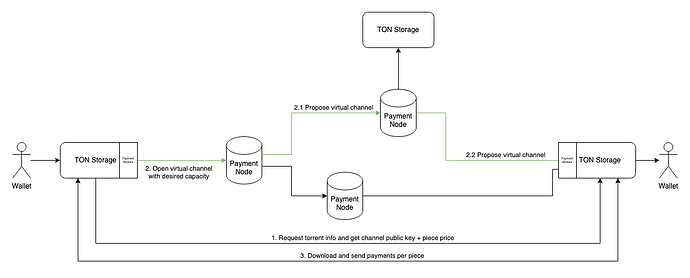Introduction to TON Payment Network
The TON Payment Network is a revolutionary peer-to-peer payment framework, designed to facilitate transactions across the TON Blockchain with unmatched efficiency and security. This document delves into the technical specifications, operational mechanisms, and unique features that set the TON Payment Network apart, providing a comprehensive look at its potential to reshape digital transactions.
Technical Specifications
The network operates on a decentralized model of payment nodes, which establish connections through smart contracts deployed on the blockchain and utilize the Reliable Datagram Protocol (RLDP) for network communication. These nodes serve dual purposes: as independent entities for transaction facilitation and as integrated libraries within applications for seamless service provision and payment functionalities, such as TON Storage and TON Proxy.
Onchain Channels
Each node actively monitors blockchain transactions to detect updates related to its contracts, such as the establishment of new contracts or events signaling non-consensual closures. To initiate a connection, a node deploys a payment channel contract specifying both parties’ public keys. Authentication over the network is secured through the exchange of messages signed with channel keys, ensuring integrity and confidentiality.
Virtual Channels
Virtual channels allow transactions between any two network points via a chain of linked nodes, without requiring direct onchain contracts between every participant. These channels are characterized by their unique keys, lifespans, capacities, and fees. For instance, a virtual channel can be established from node A to C through B, leveraging existing onchain channels (A->B, B->C) for transaction routing. Security against potential breaches in the transaction chain is guaranteed through cryptographic mechanisms and the flexible architecture of the TON blockchain.
Security Guarantees
Transactions within virtual channels occur off-chain, minimizing network fees and ensuring high-speed processing. In case of disputes, such as a node refusing to forward funds, the blockchain can be invoked to enforce the transaction based on provided proofs, ensuring risk mitigation.
Virtual Channel Anonymity
The chain’s initiator is the only entity aware of the entire node sequence, with each node only recognizing its immediate neighbors. This structure is achieved through “Garlic” packaging of tasks, where instructions are encrypted and decipherable only by the intended recipient, enhancing the network’s anonymity and security.
Network Interactions
The network’s protocol is built on two foundational actions: ProposeAction and RequestAction, ensuring transactional integrity and allowing for seamless operational flow between nodes. These actions facilitate the opening and closing of virtual channels, backed by a robust queue system that guarantees ACID compliance for all significant operations.
Performance, Reliability, and Cross-Platform Compatibility
The TON Payment Network boasts remarkable efficiency, with node operations taking mere milliseconds, allowing for high throughput of virtual channel management. Built on Go, the implementation ensures cross-platform compatibility, including mobile platforms, and leverages LevelDB for database management.
Node Management
Node operation is straightforward, with various console commands available for managing onchain and virtual channels, deploying contracts, and handling transactions. A publicly accessible node, identified by its public key 6504e4cffb6c13cabebbb6e33be9168a40900595ea1d88461733a9c8ae084232, serves as a reference point for network interactions.
Roadmap
Future developments include supporting transactions for users without an onchain wallet, MerkleProof-based virtual channels for scalability, and alternative database solutions like Postgres for enhanced data management.
Conclusion
The TON Payment Network introduces a paradigm shift in digital transactions, offering unparalleled speed, security, and flexibility. By leveraging the TON Blockchain’s capabilities and innovative channel management, it promises to significantly enhance the efficiency and accessibility of peer-to-peer payments.
